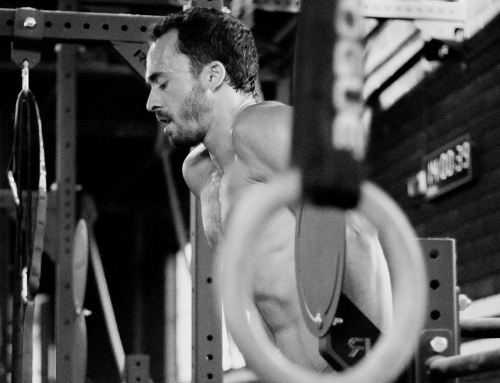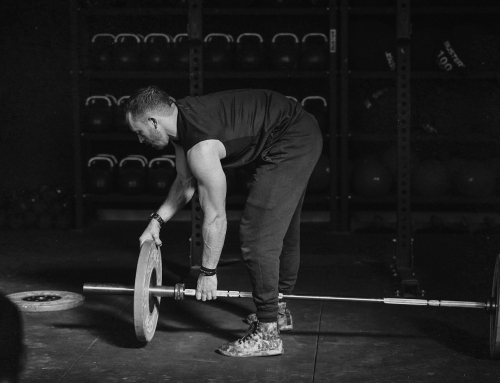Introducción
El objetivo de esta investigación fue evaluar las adaptaciones musculares en un entrenamiento resistido (es decir, entrenamiento de fuerza) de carga pesada (RT HEAVY) y otro de carga moderada (RT MODERATE) .
Método
19 hombres entrenados con ejercicios de fuerza fueron asignados aleatoriamente a una rutina RT de fuerza (HEAVY) en un rango de carga de 2-4 repeticiones por serie (n = 10) comparandola con una entrenamiento RT de hipertrofia (MODERADA) en un rango de carga de 8-12 repeticiones por serie (n = 9). El entrenamiento se realizó 3 días en semana durante 2 meses. Ambos grupos realizaron 3 series de 7 ejercicios para los principales grupos musculares de la parte superior e inferior del cuerpo. Los participantes fueron examinados antes y después del estudio para: 1 repetición máxima (RM) de fuerza en el press de banca y en sentadillas, se examinaron la resistencia muscular de la parte superior y el grosor muscular de los flexores del codo, como de los extensores y del muslo lateral.
Los resultados mostraron incrementos estadísticamente mayores en la fuerza del tren inferior a 1RM, favoreciendo el protocolo HEAVY en comparación con MODERATE. Alternativamente, se observaron aumentos estadísticamente mayores en el espesor del músculo lateral del muslo en el protocolo MODERADO versus HEAVY. Estos hallazgos indican que el entrenamiento con carga pesada es superior para los objetivos de fuerza máxima, mientras que el entrenamiento con carga moderada es más adecuado para los objetivos relacionados con la hipertrofia cuando se realiza un número igual de series en igualdad de condiciones.
Resultados
No se observaron diferencias significativas entre los dos grupos en ninguna medida de referencia. La asistencia general para los que completaron el estudio fue del 89%, sin diferencias entre las condiciones HEAVY y MODERADA (91% vs 88%, respectivamente). El VL (VL, definido como el numero total de repeticiones realizadas en un ejercicio) total semanal durante los dos meses fue significativamente mayor para MODERADO comparado con HEAVY (56049 ± 11101 vs 25867 ± 3731 kg, respectivamente).
Conclusión
Los hallazgos proporcionan evidencia de que el entrenamiento en diferentes zonas de carga provoca adaptaciones musculares diferentes en hombres cuando se realiza un número igual de series. Aunque los mecanismos siguen siendo indeterminados, podemos inferir que las adaptaciones relacionadas con la fuerza son maximizadas por el entrenamiento más cercano al 1RM. Alternativamente, los aumentos en el tamaño del músculo parecen ser impulsados más por mayores volúmenes de entrenamiento, por lo menos hasta cierto umbral. Es concebible que la combinación de estrategias de carga puede tener un efecto sinérgico sobre la fuerza y las mejoras hipertróficas.
Referencias
Abe, T., DeHoyos, D.V., Pollock, M.L. and Garzarella, L. (2000) Time course for strength and muscle thickness changes following up- per and lower body resistance training in men and women. Eu- ropean Journal of AppliedPhysiology, 81(3), 174-180.
Alway, S.E., MacDougall, J.D., Sale, D.G., Sutton, J.R. and McComas, A.J. (1988) Functional and structural adaptations in skeletal muscle of trained athletes. Journal of Applied Physiology (Be- thesda, Md.: 1985) 64(3), 1114-1120.
American College of Sports Medicine. (2009) American college of sports medicine position stand. progression models in resistance training for healthy adults. Medicine and Science in Sports and Exercise 41(3), 687-708.
Aragon, A.A. and Schoenfeld, B. J. (2013) Nutrient timing revisited: Is there a post-exercise anabolic window? Journal of the International Society of Sports Nutrition, 10(1), 5-2783-10-5.
Baechle, T.R. and Earle, R.W. (2008) Essentials of strength training and conditioning. 3rd edition. Champaign, IL: Human Kinetics. Beardsley, C. and Contreras, B. (2014) The increasing role of the hipextensor musculature with heavier compound lower-body movements and more explosive sport actions. Strength and Conditioning Journal 36, 49-55.
Campos, G.E.R., Luecke, T.J., Wendeln, H.K., Toma, K., Hagerman, F.C., Murray, T.F., Ragg, K.E., Ratamess, N.A., Kraemer, W.J., and Staron, R.S. (2002) Muscular adaptations in response to three different resistance-training regimens: Specificity of repetition maximum training zones. European Journal of Applied Physiology 88(1-2), 50-60.
Choi, J., Takahashi, H. and Itai, Y. (1998) The difference between effects of ‘power-up type’ and ‘bulk-up type’ strength training exercises: With special reference to muscle cross-sectional area. Jpn J Phys Fitness Sports Med 47(1), 119-129.
Coburn, J.W. and Malek, M.H. (2011) NSCA’s essentials of personal training. 2nd edition. Champaign, IL: Human Kinetics.
Coffey, V.G., Zhong, Z., Shield, A., Canny, B.J., Chibalin, A.V., Zier- ath, J.R. and Hawley, J.A. (2006) Early signaling responses to divergent exercise stimuli in skeletal muscle from well-trained humans. FASEB Journal: Official Publication of the Federation of American Societies for Experimental Biology 20(1), 190-192 Cooper, H., Hedges, L. and Valentine, J. (2009) The handbook of research synthesis and meta-analysis. 2nd edition. New York: Russell Sage Foundation.
Erskine, R.M., Jones, D.A., Williams, A.G., Stewart, C.E. and Degens, H. (2010) Resistance training increases in vivo quadriceps fem- oris muscle specific tension in young men. Acta Physiologica (Oxford, England) 199(1), 83-89.
Fry, A.C. and Kraemer, W.J. (1997) Resistance exercise overtraining and overreaching. neuroendocrine responses. Sports Medicine (Auckland, N.Z.) 23(2), 106-129.
Gordon, P.M., Liu, D., Sartor, M.A., IglayReger, H.B., Pistilli, E.E., Gutmann, L., Nader, G.A., and Hoffman, E.P. (2012) Re sistance exercise training influences skeletal muscle immune activation: A microarray analysis. Journal of Applied Physiolo gy (Bethesda, Md.: 1985) 112(3), 443-453.
Huczel, H.A. and Clarke, D. H. (1992) A comparison of strength and muscle endurance in strength-trained and untrained women.
European Journal of Applied Physiology and Occupational Physiology 64(5), 467-470. Ikegawa, S., Funato, K., Tsunoda, N., Kanehisa, H., Fukunaga, T. and Kawakami, Y. (2008) Muscle force per cross-sectional area is inversely related with pennation angle in strength trained athletes. Journal of Strength and Conditioning Research / National Strength & Conditioning Association 22(1), 128-131. Kawakami, Y., Abe, T., Kuno, S.Y. and Fukunaga, T. (1995) Training-induced changes in muscle architecture and specific tension.
European Journal of Applied Physiology and Occupational Physiology 72(1-2), 37-43. Kraemer, W.J., Hakkinen, K., Triplett-Mcbride, N.T., Fry, A.C., Koziris, L. P., Ratamess, N.A., Bauer, J.E., Volek, J.S., McConnell, T., Newton, R.U., Gordon, S.E., Cummings, D., Hauth, J., Pullo, F., Lynch, J.M., Fleck, S.J., Mazzetti, S.A., and Knuttgen, H.G. (2003) Physiological changes with periodized resistance training in women tennis players. Medicine and Science in Sports and Exercise 35(1), 157-168.
Kraemer, W.J. and Ratamess, N.A. (2004) Fundamentals of resistance training: Progression and exercise prescription. Medicine and Science in Sports and Exercise 36(4), 674-688. Krieger, J.W. (2009) Single versus multiple sets of resistance exercise: A meta-regression. Journal of Strength and Conditioning Re- search / National Strength & Conditioning Association 23(6), 1890-1901. Mangine, G.T., Hoffman, J.R., Gonzalez, A.M., Townsend, J.R., Wells, A.J., Jajtner, A.R., Beyer, K.S., Boone, C.H., Miramonti, A.A., Wang, R., LaMonica, M.B., Fukuda, D.H., Ratamess, N.A., and Stout, J.R. (2015) The effect of training volume and intensity on improvements in muscular strength and size in resistance- trained men. Physiological Reports 3(8), pii: e12472.
Masuda, K., Choi, J.Y., Shimojo, H. and Katsuta, S. (1999) Maintenance of myoglobin concentration in human skeletal muscle after heavy resistance training. European Journal of Applied Physi-ology and Occupational Physiology 79(4), 347-352.
Maughan, R.J., Watson, J.S. and Weir, J. (1984) Muscle strength and cross-sectional area in man: A comparison of strength-trained and untrained subjects. British Journal of Sports Medicine 18(3), 149-157.
Meijer, J.P., Jaspers, R.T., Rittweger, J., Seynnes, O.R., Kamandulis, S., Brazaitis, M., Skurvydas, A., Pisot, R., Simunic, B., Narici, M. V., and Degens, H. (2015) Single muscle fibre contractile properties differ between body-builders, power athletes and control subjects. Experimental Physiology 100(11), 1331-1341. Narici, M.V. and Kayser, B. (1995) Hypertrophic response of human skeletal muscle to strength training in hypoxia and normoxia. European Journal of Applied Physiology and Occupational Physiology 70(3), 213-219.
Ogasawara, R., Thiebaud, R.S., Loenneke, J.P., Loftin, M. and Abe, T. (2012) Time course for arm and chest muscle thickness changes following bench press training. [null] Interventional Medicine and Applied Science 4(4), 217-220.
Phillips, S.M., Tipton, K.D., Ferrando, A.A. and Wolfe, R.R. (1999) Resistance training reduces the acute exercise-induced increase in muscle protein turnover. The American Journal of Physiolo
gy 276(1 Pt 1), E118-24. Reeves, N.D., Maganaris, C.N. and Narici, M.V. (2004) Ultrasonograph-ic assessment of human skeletal muscle size. European Journal of Applied Physiology 91(1), 116-118.
Sale, D.G. (1988). Neural adaptation to resistance training. Medicine and Science in Sports andExercise 20(5 Suppl), S135-45. Sale, D.G., MacDougall, J.D., Alway, S.E. and Sutton, J.R. (1987) Voluntary strength and muscle characteristics in untrained men and women and male bodybuilders. Journal of Applied Physiology (Bethesda, Md.: 1985) 62(5), 1786-1793.
Sale, D.G., Upton, A.R., McComas, A.J. and MacDougall, J.D. (1983) Neuromuscular function in weight-trainers. Experimental Neurology 82(3), 521-531.
Schoenfeld, B.J., Pope, Z.K., Benik, F.M., Hester, G.M., Sellers, J.,Nooner, J.L., Schnaiter, J.A., Bond-Williams, K.E., Carter,A.S., Ross, C.L., Just, B.L., Henselmanns, M., Krieger, J.W. (2016) Longer inter-set rest periods enhance muscle strength and hypertrophy in resistance-trained men. Journal of Strength and Conditioning Research, 30(7), 1805-1812. Schoenfeld, B.J. (2010). The mechanisms of muscle hypertrophy and their application to resistance training. Journal of Strength and
Conditioning Research / National Strength & Conditioning As- sociation 24(10), 2857-2872. Schoenfeld, B.J., Ogborn, D. and Krieger, J.W. (2016) Dose-response relationship between weekly resistance training volume and in creases in muscle mass: A systematic review and meta-analysis. Journal of Sports Science [Epub ahead of print], Nov 2:1-3. Schoenfeld, B.J., Peterson, M.D., Ogborn, D., Contreras, B. and Sonmez, G.T. (2015) Effects of low- versus high-load resistance training on muscle strength and hypertrophy in well-trainedmen. Journal of Strength and Conditioning Research / National
Strength & Conditioning Association 29(10), 2954-2963. Schoenfeld, B.J., Ratamess, N.A., Peterson, M.D., Contreras, B., Tiryaki-Sonmez, G. and Alvar, B.A. (2014) Effects of different volume equated resistance training loading strategies on muscular adaptations in well-trained men. Journal of Strength and Conditioning Research / National Strength & Conditioning Association 28(10), 2909-2918.
Tang, J.E., Perco, J.G., Moore, D.R., Wilkinson, S.B. and Phillips, S.M.(2008) Resistance training alters the response of fed state mixed muscle protein synthesis in young men. American Journal of Physiology.Regulatory, Integrative and Comparative Physiology 294(1), R172-178. Wakahara, T., Fukutani, A., Kawakami, Y. and Yanai, T. (2013) Nonu- niform muscle hypertrophy: Its relation to muscle activation in training session. Medicine and Science in Sports and Exercise, 45(11), 2158-2165.
Wakahara, T., Miyamoto, N., Sugisaki, N., Murata, K., Kanehisa, H., Kawakami, Y., Fukunaga, T., Yanai, T. (2012) Association be tween regional differences in muscle activation in one session of resistance exercise and in muscle hypertrophy after resistance training. European Journal of Applied Physiology 112(4), 1569-1576.
Wilkinson, S.B., Phillips, S.M., Atherton, P.J., Patel, R., Yarasheski, K. E., Tarnopolsky, M.A. and Rennie, M.J. (2008) Differential effects of resistance and endurance exercise in the fed state on signalling molecule phosphorylation and protein synthesis in human muscle. The Journal of Physiology 586(Pt 15), 37013717.





